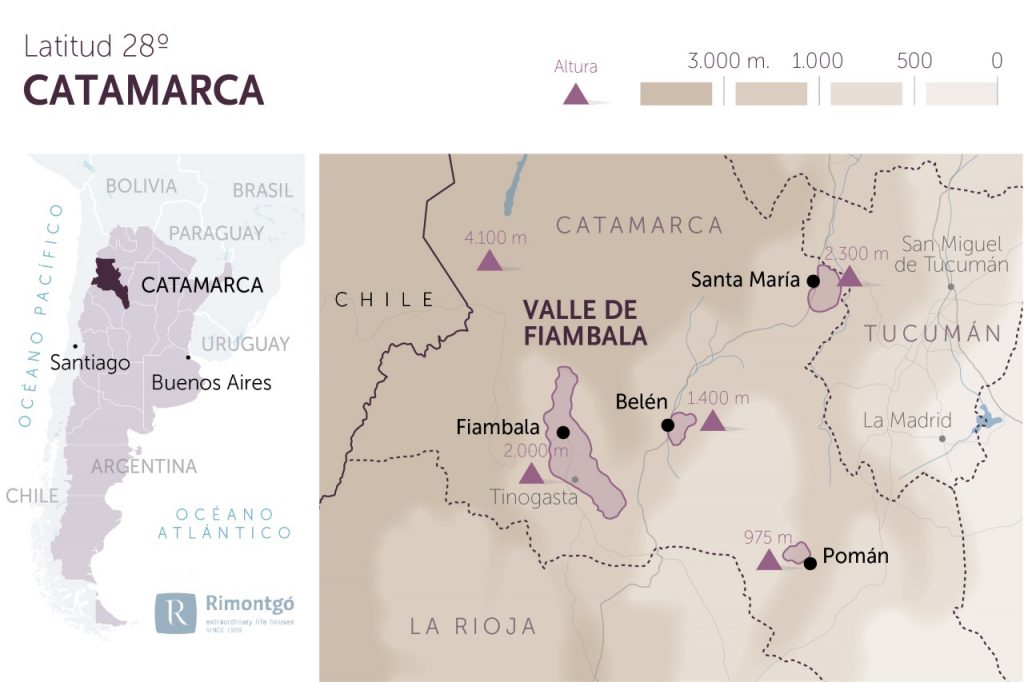In the sun-scorched altiplano of northwestern Argentina, the wine regions of Tinogasta and Fiambalá stand as testament to the resilience of viticulture in the face of extreme geography. Located within Catamarca province, these desert vineyards thrive at elevations ranging from 1,200 to over 1,900 meters above sea level, nestled in valleys carved by Andean winds and hemmed by rugged mountain ridges. Here, vines grow amid rocky outcrops, sandy terraces, and dry riverbeds, capturing the essence of a terroir shaped by altitude, aridity, and stark temperature swings.



Viticulture in Catamarca traces its origins back to the Spanish missionaries of the 16th century. However, only in the late 20th century did serious commercial production emerge. Key milestones include the founding of Bodega Alta Esperanza by the Longo family, whose vineyards benefit from the volcanic soils near Tinogasta, and the biodynamically farmed Cabernet de los Andes, situated in Fiambalá’s high reaches. Today, Catamarca’s wines increasingly attract the attention of sommeliers and wine professionals worldwide, standing apart for their purity, structure, and desert-born character.

Bodega Alta Esperanza in Tinogasta, founded by Vittorio Longo and now operated by Juan Longo, exemplifies this evolution. Located at 25 de Mayo Sur, Tinogasta, its 40 hectares of organically farmed vines flourish under intense sunlight and cool Andean nights. Visitors can explore their portfolio, which includes a structured Malbec with black fruit and violet notes, a crisp and aromatic Torrontés with hints of orange blossom and lime, and a bold Syrah rich in black pepper and dark chocolate flavors. Alta Esperanza’s Reserva Malbec, aged for 12 months in French oak barrels, showcases the winery’s commitment to elegance and structure. Contact details include phone (+54 3837 45-2001), email (info@altaesperanza.com), and their website (www.altaesperanza.com). They are active on Instagram (@altaesperanzawines), LinkedIn, and TikTok.
Finca Don Diego, near Fiambalá on Ruta 60, draws from heritage vineyards dating back to 1702. Today, 80 hectares of organic-certified vines, grown in stony terraces, yield robust Cabernet Sauvignon with notes of cassis and eucalyptus, spicy Syrah layered with red fruits and mineral tones, and a fruit-forward Malbec with earthy undertones. Their Chardonnay stands out for its mineral-driven palate and subtle vanilla finish. The distinctive adobe and stone winery is both a production site and a cultural heritage landmark. Visitors can schedule tours via their website (www.fincadondiego.com), with further updates via Instagram and X (formerly Twitter).
Cabernet de los Andes, known locally as Tizac, occupies Finca La Retama at nearly 1,800 meters altitude. Founded in 2002 by Carlos Arizu, it employs biodynamic methods, emphasizing lunar cycles, especially during their famed Plenilunio (full moon) harvest. Their flagship Plenilunio Malbec is a dense, inky wine with profound minerality, black cherry, and graphite notes. Their Cabernet Franc, aged in amphora, delivers vibrant red fruit, fine tannins, and savory herbal complexity. Chardonnay and Viognier, fermented with native yeasts, complete their range, offering floral aromatics and balanced acidity. Contact is via www.cabernetdelosandes.com and social media platforms Instagram and TikTok (@cabernetdelosandes).
Bodega Veralma operates in the higher reaches near Villa San Roque, producing Malbec, Syrah, and their signature Reserva blends from 400 hectares of vineyard terraces. Utilizing solar power and gravity-fed cellars, Veralma has become a leader in sustainable large-scale production. Their Gran Reserva Malbec features concentrated blackberry and plum flavors with a smoky oak finish, while their Syrah offers a silky texture with pronounced black pepper and blue fruit notes. Torrontés, often vinified in stainless steel tanks to preserve its aromatic freshness, remains a flagship white wine for Veralma. They offer virtual tours on their website (www.bodegaveralma.com) and share news through Instagram and LinkedIn.
Cuello Roca, Bodega Longo, and Finca Rodríguez Ferrero round out the region’s prominent producers, each cultivating high-altitude vineyards and focusing on single-varietal bottlings and traditional blends. While Bodega Longo specializes in a highly aromatic Torrontés and supple Bonarda with ripe red berries and soft tannins, Rodríguez Ferrero’s reputation rests on its structured Syrah, noted for its complex spice profile and velvety tannins. Cuello Roca is known for their Petit Verdot and a limited-production Cabernet Sauvignon Reserve, both expressing firm structure and desert minerality.
Topographically, the Catamarca wine region is defined by its contrasting landscapes. Steep mountain walls flank narrow valleys, where vineyards are often planted on terraced slopes composed of sandy loam, volcanic ash, and granite scree. The topography not only creates dramatic scenery but also promotes excellent drainage, critical for the low annual rainfall averaging less than 200 mm. Elevation-induced diurnal shifts result in daytime highs over 30°C dropping to 10°C at night, locking acidity into the grapes. The region’s rivers, such as the Abaucán and Fiambalá, provide vital irrigation, channelled through traditional acequias and modern drip systems. Wind, especially the dry Zonda, shapes viticultural practices, necessitating windbreaks and adaptive canopy management.
In terms of wine profiles, Catamarca’s Malbec displays a darker, more herbal expression than its Mendoza counterpart, often with violet aromatics, firm tannins, and a lingering minerality. Torrontés, thriving in the desert’s intense sunlight, shows vibrant citrus and floral notes, balanced by crisp acidity. Producers increasingly experiment with amphora aging and native yeast fermentations, amplifying the wines’ connection to their terroir. Syrah from the region is typically rich and spicy, while Cabernet Sauvignon and Cabernet Franc reflect high-altitude freshness and complex structure. Bonarda and Petit Verdot, though less common, showcase ripe fruit flavors balanced by firm tannins and pronounced minerality.
The wineries of Catamarca, from the terraces of Fiambalá to the sunbaked plains of Tinogasta, are pioneering a new chapter in Argentine wine. Sustainability practices such as solar-powered wineries, organic certifications, and biodynamic farming underscore a regional philosophy rooted in respect for land and tradition. For sommeliers, wine lovers, and international producers seeking unique, desert-driven wines, Catamarca offers both inspiration and discovery.